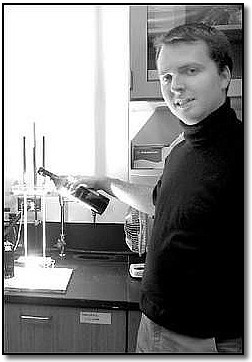
Image: Toledo Blade / Jetta Fraser
 |
UT doctoral
candidate Yann Roussillon is part of a team that has found a way to
increase solar cell efficiency. Image: Toledo Blade / Jetta Fraser |
"While a glass of aniline with dinner would have distressing effects, it works on solar cells because it too contains charged particles."
| Red wine, what can
beat it? It reduces your risk of heart disease. It's full of
cancer-fighting compounds. And now, researchers at the University of
Toledo reveal yet another use for the juice of the grape. It makes better solar cells. UT researcher Yann Roussillon didn't expect wine to boost the efficiency of solar cells. Still, the doctoral candidate was game when UT physics professor Victor Karpov proposed the idea of wine-soaked solar cells in a brainstorming session. No, they weren't drinking at the time. Dr. Karpov had a hunch that the chemical properties of wine could help solve a major problem in solar cells made out of cadmium and telluride. Unfortunately for Ohio's wine crop, this isn't really a practical way to make solar cells. So Mr. Roussillon found a substance that shared wine's properties. A paper in the current issue of Applied Physics Letters shows that the research team settled on a chemical called aniline. While a glass of aniline with dinner would have distressing effects, it works on solar cells because it too contains charged particles. In fact, aniline performed slightly better than wine, raising solar cell efficiency to the industry average of 12 percent. While cadmium-telluride solar cells will convert sunlight into electrical energy, they do so stingily. Only 1 to 3 percent of the light that strikes the cell turns into electricity. Despite efforts to goose the efficiency rate to an average of 10 to 12 percent, methods generally are expensive and often inefficient. Cadmium cells start with a layer of glass, then a slather of a transparent oxide, followed by a sheet of cadmium sulfide, then cadmium telluride, and finally a metal sheet that acts as the electrical contact. While the solar cell looks ice-rink smooth, it's really a roughlandscape. Electrons traveling across the surface lose their way in its many valleys. Red wine contains microscopic spheres called colloidal particles. Each sphere carries an electrical charge. When wine spills across the cadmium-telluride layer, these particles fill in the valleys, smoothing the electrons' path. The result? Solar cells that can convert some 9 percent of the light that strikes them into energy - nearly as good as all-but the most experimental and expensive processes. The university has applied for a patent on the aniline process. "It's interesting work," said Ken Zweibel, at the National Renewable Energy Laboratory. NREL is a part of the U.S. Department of Energy However, the market value of the invention must be proven. "It's really too early to tell,'' said Chip Hambro, general manager of First Solar, which makes cadmium-telluride solar cells. Article reprinted with permission of The Blade, toledoblade.com, Feb. 10, 2004 |
|
|
| For
Further Information: • The Toledo Blade Please Note: SolarAccess.com and Arizonaenergy.org do not endorse the sites behind these links. We offer them for your additional research. Following these links will open a new browser window. |
Copyright © 1999 - 2004 - SolarAccess.com